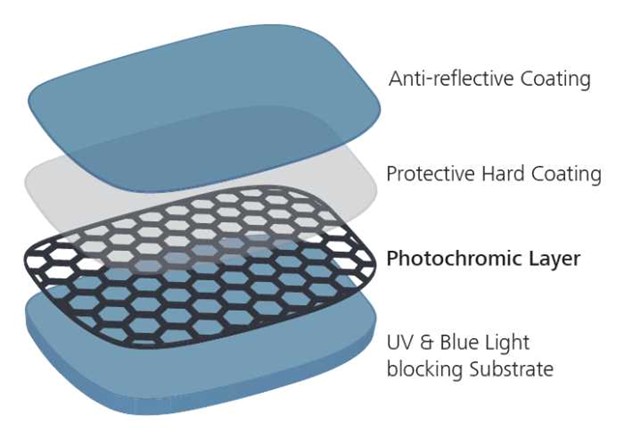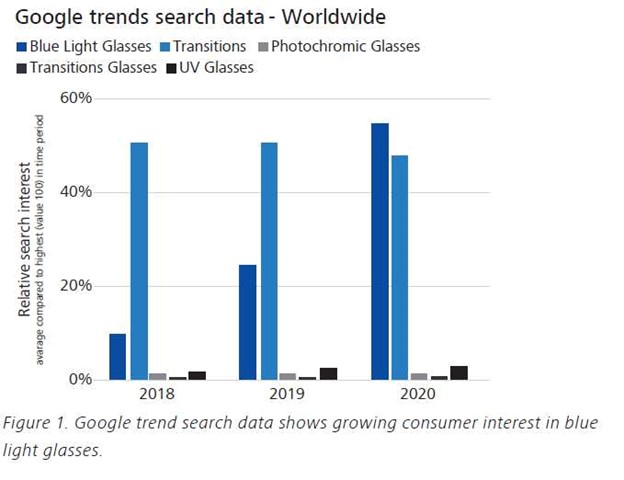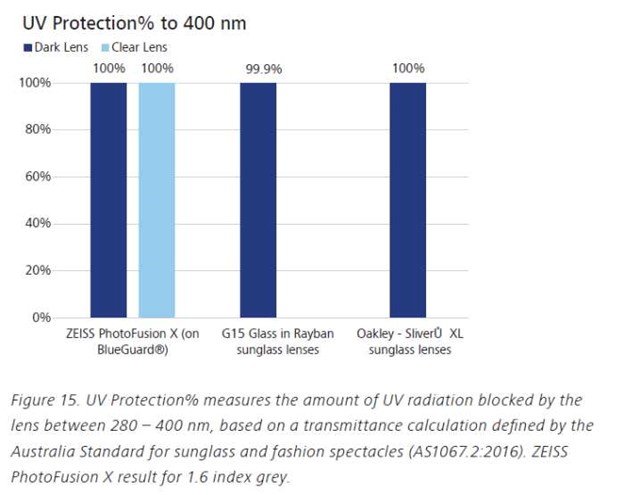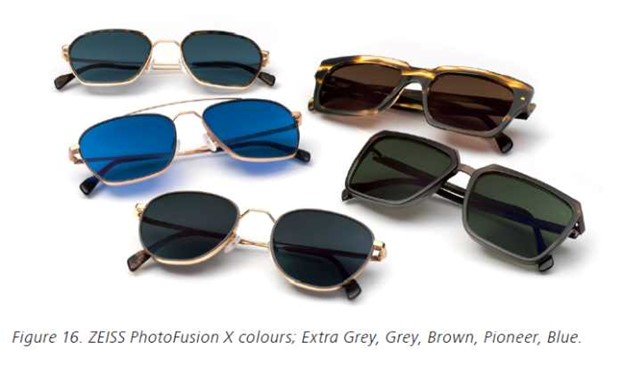ZEISS PhotoFusion X is a complete photochromic lens portfolio uniquely designed to satisfy your patients’ need for speed-to-clear with blue light and UV protection. ZEISS has re-engineered its photochromic system to deliver ground-breaking transition speeds, improved darkness, excellent UV and blue light protection and attractive colors – all with premium ZEISS quality. ZEISS launched this new photochromic lens at Vision Expo East in New York.
What makes it unique?
The cutting-edge photochromic technology that uses ZEISS BlueGuard as a base material and includes the sunglass-level UV protection of ZEISS UVProtect, give your patients protection both indoors and out. New ZEISS PhotoFusion X provides excellent blue light and UV protection in any environment.

A Completely New Photochromic System
The photochromic system in ZEISS PhotoFusion X lenses is much more efficient than with previous self-tinting lenses. It includes a new generation of specially developed and patented dyes in a robust and more open carrier matrix for faster transition, allowing them to be clearer indoors, darker outdoors, and quicker to react than previous generations.
Speed Matters
Patients frequently buy a range of prescription lenses: clear, sunglasses, and more recently, blue light protection glasses. However, having many prescription eyeglasses is pricey and can be an inconvenience to some.
When people are indoors, they typically want their lenses to be clear. When stepping outdoors, their eyes perceive light and glare, and they want sunglasses that provide comfortable protection.
Early generations of photochromic glasses were not dark enough or were too slow to clear when coming indoors. Slow fade-back speed is a visual inconvenience, as it’s difficult to see indoors with dark lenses, and in social situations it can be embarrassing.
Fast transition is important to patients:
- For many patients, quick clearing indoors is the most important feature in photochromic lenses.[2]
- Slow change from dark to light is the most common pain point for photochromic lens wearers.

- “too slow to go clear” was the most cited technical performance reason for not purchasing photochromic lenses.[3]
- In the same study, 100% of experienced photochromic lens wearers noted “clearing up fast inside” is an important characteristic, even more so than darkness or indoor clarity.
ZEISS collaborated with Colts Laboratories, an independent ophthalmic lens testing company in the USA, to measure the photochromic properties of PhotoFusion® X lenses and compare them to the latest lenses from other brands.
The Colt’s independent tests lead to the following conclusions:
PhotoFusion® X Grey is up to 1.5 times faster to clear than the most common photochromic brand’s latest generation grey(14) .
PhotoFusion® X Pro Grey is up to 4.5 times faster to clear than the most common photochromic brand´s latest generation grey., comparing average fade-back speed to an interpolated time to 80%T. [4]
PhotoFusion® X Brown was twice as fast as the same brand’s latest brown. [5]
Artificial Blue Light: A 21st-Century Problem
Modern artificial light sources such as LED lights and the usage of digital devices like computer screens, tablets, TVs and cell phones are increasing the eyes’ exposure to artificial blue light. While longer wavelength blue light, that that from the sun, can help us stay alert and awake, shorter wavelengths, like those from digital devices, can generate visual irritation and may even harm the eyes. In addition, blue light is thought to contribute to digital eye strain, causing symptoms like blurry vision and visual discomfort.[7]
Online concern is propelling blue light lens sales. People are looking for “blue light glasses” online at a greater rate than before. Google searches for blue light glasses have increased five-fold in two years (figure 1).[8] In 2020, the term (blue light glasses) outpaced photochromic lenses searches.

UV Radiation- A Hidden Danger for Our Eyes
UV radiation is not visible to the human eye but poses potential risks to eye health. Without protection, UV radiation may damage anterior ocular structures and the skin around the eyes.
Eyelids and periorbital skin:
UV induced eyelid damage is common. Experts usually recommend sunscreen on the eyelids to prevent damage, but people often do not take this safety measure because sunscreen can cause eye irritation.
UV radiation may cause several chronic skin conditions:
• Eyelid photo-aging, which makes the skin thicker and generates prominent wrinkles;
• Sebaceous gland damage;
• Skin cancer on the eyelid
Lens: As the eye ages, protective pigments in the lens are converted into pigments that react to UVR, further damaging lens proteins and the lens’s outer layer. When damage accumulates, the lens can develop a cataract, severely compromising vision.
Iris: Melanoma tumors are the most common cancer of the eye, and evidence suggests that UVR is one of its leading causes.[9]
Retina: In young people, some longer UVR wavelengths may reach the retina and cause photochemical damage.
Because of this ZEISS provides sunglass-level UV protection in all clear ZEISS lenses. ZEISS PhotoFusion X lenses provide sunglass-level UV protection up to 400 nm in both the clear and activated states. This protection is built into ZEISS BlueGuard materials. This means PhotoFusion® X lenses provide the same UV blocking as premium sunglasses.

Premium sunglasses typically offer full UV protection to 400 nm; however, people may not own a pair and often do not wear them on cloudy days. A Vision Council of America survey found only 21.2% always wear sunglasses when outdoors.[10]
PhotoFusion® X are everyday lenses, for use indoors and outdoors, so wearers have them on all the time, providing more reliable and consistent UV protection. As a result, PhotoFusion® X lenses may provide the average wearer better protection over time from UV radiation than sunglasses.
Fashionable Protection
Through its Sunlens Division, ZEISS supplies non-prescription sunglass lenses to many of the leading sunglass brands, giving ZEISS unique insights into popular sunglasses fashions and color choices.

ZEISS PhotoFusion X lenses are currently available in six colors including a classic sunglass grey, a fast Pro Grey, a warm sunglass brown, a fast Pro Brown, the pioneer grey-green and a vibrant blue. Utilize ZEISS PhotoFusion X lenses in the latest eyewear trends for fashionable and functional styles.
The Best Overall Photochromic Lens Technology
There are many photochromic lens choices available to eye care professionals. Amongst this field of products, ZEISS PhotoFusion X provides the best total package of performance and protection when viewed across the variables that eyeglass wearers most value. Faster fade-back to clear, providing sunglass level darkness outdoors, higher indoor and outdoor blue light protection, sunglass-level UV protection and excellent clarity indoors.

Key Benefits
Outdoors, ZEISS PhotoFusion X lenses are performance optimized self-tinting lenses that provide glare, blue light and UV protection.
• Sunglass-level (Cat 3) darkness outside
• UV Protection to 400 nm
• Excellent blue light blocking
• New and improved color hues
Indoors, PhotoFusion® X provides blue light protection and clarity.
• Excellent blue light protection indoors (blocks up to 50% of potentially harmful blue light).
Photofusion® X provides ground-breaking transition speeds.
• Speed-to-clear – up to 4.5 times (450%) faster than the most common photochromic brand´s latest generation, and up to 47% faster than previous PhotoFusion® lenses.[4], [12]
• Speed-to-dark – up to 75% faster than previous PhotoFusion® lenses(15), achieving over 70% absorption in as little as 15 seconds and full sunglass-level (cat 3) darkness in as little as 27 seconds.[13]
At ZEISS we believe that since photochromic lenses are used all day and, in all environments, they should offer high level protection in both environments. Wearers want to protect their eyes and vision no matter if they are exposed to artificial blue light indoors or solar radiation while spending time outdoors. ZEISS PhotoFusion X does just this.
To learn more about ZEISS PhotoFusion X click here or ask your ZEISS Business Development Representative for more information.
If you’d like to find out more about becoming a ZEISS customer, please visit https://www.zeiss.com/vision-care/us/eye-care-professionals/contact.html
References:
[1] External Eyeglass Wearer Studies, (n=151 clear lens wearers) DE, 2021.
[2] Photochromic Lens Wearer Study in the UK (n=232) in 2021 external institute).
[3] External Eyeglass Wearer Studies (n=105), DE, 2012
[4] Testing by independent testing laboratory in USA in 2021-22 according to requirement in ISO 8980-3. Based on the average speed (%T/min) of fadeback from fully activated state to the interpolated time to 80%T at 23C in 1.50 index HC only form (CR607 version of comparison brand).
[5] Analyses by Technology and Innovation, Carl Zeiss Vision GmbH, Aus 2021. Based on the average speed (%T/min) of fadback from fully activated state to 80%T at 23C in 1.50 index HC only form, comparison brand CR607 version.
[6] Testing by independent testing laboratory in USA according to requirement in ISO 8980-3. Based on the average speed (%T/min) of fade-back from fully activated state to 80%T at 23°C in 1.5 index (CR607) HC only form.
[7] Rosenfield M. (2011). Computer vision syndrome: a review of ocular causes and potential treatments. Ophtalmic Physiol Opt., (5):502-15.
[8] Google trends weekly result for country selection Worldwide from 1/1/2018 to 12/31/2020 for the terms “blue light glasses”, “photochromic glasses”, “transitions”, “Transitions glasses” and “uv glasses”, Data analysis as of July 2021.
[9] Jovanovic P, Mihajlovic M, Djordjevic-Jocic J, Vlajkovic S, Cekic S, Stefanovic V. Ocular melanoma: an overview of the current status. Int J Clin Exp Pathol. 2013;6(7):1230-1244. Published 2013 Jun 15.
[10] Vision Council of America, UV Eye Protection Study, 2018. 1.5
[11] Testing according to requirement in ISO 8980-3. Based on the average speed (%T/min) of fadeback from fully activated state to 80%T at 23°C in 1.5 index (CR607) HC only form.
[12] Analyses by Technology and Innovation, Carl Zeiss Vision GmbH, Aus 2021 in accordance to ISO 8980-3. Based on the average speed (%T/min) of activation from from clear state to 30%T at 23C in grey polycarbonate HC only form.
[13] Analyses by Technology and Innovation, Carl Zeiss Vision GmbH, Aus 2021 in accordance to ISO 8980-3. PhotoFusion X Grey at 23°C, 1.6 index with HC
(14) Testing by independent testing laboratory in USA in 2021-22 according to requirement in ISO 8980-3. Based on the average speed (%T/min) of fadeback from fully activated state to the interpolated time to 80%T at 23C in 1.50 index HC only form (CR607 version of comparison brand).
(15) Testing by independent laboratory in USA in 2021-22 according to requirement in ISO 8980-3. Based on the average speed (%T/min) of activation from clear state to an interpolated time to 30%T at 23C in grey polycarbonate HC only form.
[…] Zeiss PhotoFusion X is the new and improved generation of ZEISS photochromic lenses that turn dark outdoors and clear up again when the wearer is inside. Zeiss PhotoFusion X tints to sunglass-level darkness in second and clears up to 2.5 x faster indoors. […]
Hi there! Lens technology articles often spark curiosity about daily comfort rather than specs alone. A long commute under shifting light revealed how eye fatigue builds quietly. Discussions moved toward reliability and adaptation speed. In that context, guidance like how to contact ray ban fit smoothly into evaluating support and warranty expectations. The insight shifted focus toward usability instead of novelty. Additional reflection came from reading user stories that emphasized consistent performance over dramatic claims, reinforcing thoughtful selection. Additional reflection came from everyday follow-ups, conversations with peers, and comparing outcomes over time, which reinforced patience, clarity, and realistic expectations during similar situations.